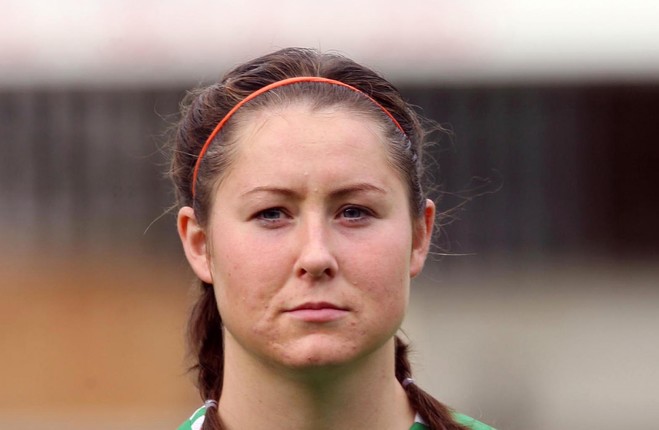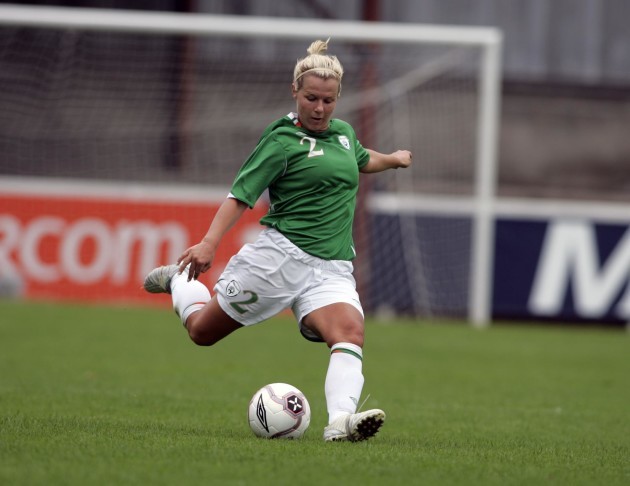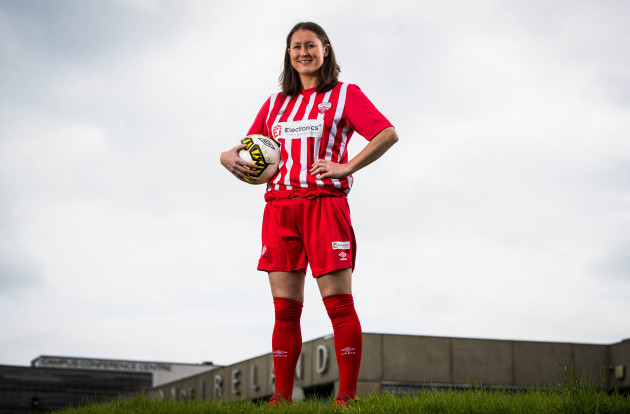Updated at 10.34
‘OBSESSION’ IS a word Marie Curtin uses on multiple occasions over the course of this interview.
And it is a quality that is certainly required to have played as long as she has at elite level, amid a Women’s National League that’s still marred by ‘pay-to-play’ restrictions.
The experienced defender’s dedication was evident from an early age. She was the second youngest in her family, growing up on a farm in Limerick with three brothers and three sisters.
As is the case with so many future elite female players, Curtin started out playing boys’ football.
“The first time they saw me, they put me on the B team straight away,” she tells The42. “Even at that young age, around 10, I was saying: ‘For God’s sake.’
“I knew I wasn’t a B team player. But from then on, I was A team all the way. It’s just that perception. You learn very young, girls are [seen as] very different and there’s not a lot expected of us. Every team we played then, it was the same thing, nobody wanted to mark the girl. But then, they were always pleasantly surprised [by my ability].
“They think, because you’re a girl, you’re not going to be good. So it was always funny seeing those kinds of [surprised] reactions.”
Curtin’s career really took off when she started playing for Ennis-based Lifford Ladies around the age of 13. They were a club renowned for producing Irish internationals and were one of the top sides in the country at a time prior to the Women’s National League’s existence.
That move led to trials with Irish underage teams and an eventual breakthrough at senior level.
Then, just after turning 19, Curtin moved to America, spending four years at Hofstra University on a soccer scholarship.
The experience abroad taught her what was truly required of an elite athlete, as she competed in a full-time environment and with a level of intensity that she had not been accustomed to previously.
Crucially, at Hofstra, there was also a degree of equality, which was rare enough for female athletes at the time — funding to the women’s programme was exactly the same as what was granted to their male counterparts.
“It was a crazy difference to what I was used to,” she recalls. “They really made me an athlete out there. There were ridiculous amounts of training, you’re in the gym from 6am, you’re doing strength and conditioning, and football training.
“It just felt like a really different experience, it was good for my development.”
Curtin was far from the only Irish footballer over there at the time — she also encountered Elaine O’Connor, Dolores Deasley, Diane Caldwell, Edel Malone, Emma Kilduff and Kariena Richards during her Stateside stint.
The young centre-back also spent time playing semi-professional football with Long Island Fury in the Women’s Premier Soccer League, the second tier of soccer in North America, which she helped them win in 2006. Her team-mates included Allie Long, who has won 51 caps for USA, while her coach was Paul Riley, now in charge of Denise O’Sullivan’s North Caroline Courage.
Being away from Irish-based family and friends was tough, but after four years, this invaluable voyage came to an end.
So in contrast with the high standards Curtin was used to in the US, did playing back in Ireland pale by comparison?
“I wouldn’t say it was a comedown, but this is where we are. In America, it’s always a matter of funds and a matter of who’s running the thing.
“I’ve been very proud to play for my country as well, but I think [USA] just opens your mind to what can be really — the opportunities and to see the levels and the way they do things, it was a great experience for that reason. Now being back in Ireland, I’d like to try to be involved and make the standard better here as well if I go into coaching.”
Following her return to Ireland, Curtin “dabbled in different things”. She had played GAA growing up and went back to the sport, helping Limerick win the All-Ireland Junior Ladies’ Football Championship in 2010.
“I hadn’t played Gaelic in about nine years. I bumped into people and I ended up getting back into the game and playing intercounty football again.
“But there are players who have been trying for years and years to win Munster Championships, All-Ireland Championships and been unsuccessful. I rock back years later and we win an All-Ireland Championship. It was great, I’m delighted I had that experience.”
After a short period playing with Kilmallock United in which she earned a runners-up medal in the 2010 FAI Women’s Junior Cup, Curtin subsequently joined Cork City for the inaugural season of the Women’s National League, with the team finishing third in what was then a six-team division.
She later spent a campaign playing in Norway with Fortuna Alesund in 2012, which she describes as “a great experience”.
Curtin adds: “I could have easily stayed and moved to Oslo with some friends there. But I just thought long and hard and felt the right decision was to call it a day at that point.”
Only in her late 20s, Curtin retired from international football, having spent 10 years representing the Irish team in various World Cup and European Championship qualifiers, citing a game in front of around 40,000 spectators in Chicago against the USA as a highlight.
Of her decision to retire from Ireland duty, she explains: “You’re looking at other countries and how they’re progressing. So when things stay the same [in Ireland], it can be frustrating. I suppose when you dedicate your life to it, it does make you step back and ask: ‘What am I getting out of it?’
“When I finished my year in Norway, I was around 27 and it’s just one of those things where you worry about your career. You didn’t get the same opportunities as a women’s international player, so I thought: ‘I need to be smart here and start looking at a career [away from football] for myself.’
“You might say to yourself if you’re watching US Soccer: ‘Okay, they’ve got tonnes of funds, Germany, they’ve the funds and the resources, they’re able to do that.’ You see them all developing. But then, you look at Scotland, they’re developing and you’re like: ‘Still, we can’t match that?’ So it was disappointing from that point of view and it ultimately led to my decision: ‘I need to step away here, I don’t have a career to fall back on. I don’t have opportunities that my male counterparts would have.’ So I made a very logical decision.”
Curtin consequently took a step back from football. In 2013, with her father, Sean, she founded a dairy foods company, Temple Dairy Ltd, whose main product was a healthy chocolate milk drink and which she worked on for five years. She even appeared as a contestant on Irish TV show Dragon’s Den in 2017.
She didn’t stop playing entirely, but Curtin admits football “took a backseat” while she was focusing on these new endeavours.
“I played my sport as an outlet really and I still enjoyed that level of playing, but being honest, it wasn’t my obsession, like it would have been in previous years when I was just trying to develop my own game and the training that is required for international football. I still loved my training and tried my hardest, but the business was number one for me and it required a serious commitment.”
Prior to the 2014-15 season, Curtin signed with Galway and spent a couple of seasons there, before joining Limerick for the last three years of her WNL career.
Having been part of the league since its inception, the veteran star has been encouraged by recent strides made by women’s football in Ireland.
“I’ve seen a big difference this last year,” she says. “Is that because the PFAI have been pushing for change as well? I don’t know. But I definitely saw a lot more focus on the Women’s National League this year, just on the exposure.
“The media has been unbelievable this year, the level of reports and consistent games that have come out from the media side has been really good. So it is getting better. I can absolutely see that from this last season that we’ve had.
“There’s a lot of room for improvement in things that can be done. But I’m enthusiastic. I think that things will get better and I’m just hoping as well. I suppose the environment is changing all the time. Now we have such [impressive] technology. The digital marketing space is blowing up. Digital marketing is the future. Just watching what US Soccer do or the WPS in America, what they do, in terms of promoting and marketing the game [is inspiring].
“What the women’s league in England does now, how they join it with the men. They have the FA Player app and how they promote the game with that. The content is unbelievable and I just hope the FAI are taking notes on what’s going on around the world. Women’s soccer is getting huge and I just wish the best for the national team and the WNL now.
“I just hope things will progress to give opportunities to young girls growing up, because there’s serious talent in this country and it would be a shame for the same to happen again. In my era, we have seen so many players come and go without success, so I really hope for the good of the game that things develop for our sport.”
Curtin announced her retirement from playing at the age of 35 earlier this month, but remains as busy as ever. She works as an administrator for Limerick Sports Partnership through Sport Ireland, while she is also doing a higher diploma in digital marketing.
Coaching is another passion. She did her Uefa B licence two years ago, while once normality resumes and the current coronavirus-related restrictions are eased, she is due to take charge of an U15 girls team at the Gaynor Cup, which is widely regarded as the most prestigious competition for underage women’s football in Ireland.
And the Limerick native admits part of her would love to be a teenager again, given the increased options nowadays for female footballers in Ireland.
“There are emerging talent programmes there now. There are more steps on the ladder for that player pathway. What you’d give now to be a 15-17-year-old, and on that pathway. And there are real opportunities for girls to actually go and be really successful abroad too. But you have an opportunity to be successful in Ireland with the WNL also.
“It’s an exciting time for women’s football in Ireland, because it’s now getting more attention. The FAI [recently] had a poster on their social media with Aine O’Gorman and a few other senior women’s internationals on the same poster as the men’s international players. That kind of statement, I know it might feel like nothing for anybody else, but to show them on the same poster is a big statement as far as I’m concerned. It shows that level of equality, which is cool to see.”




